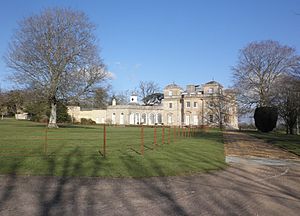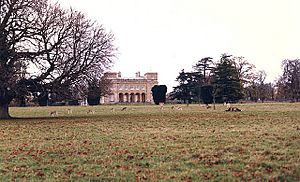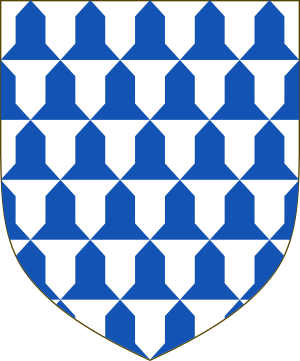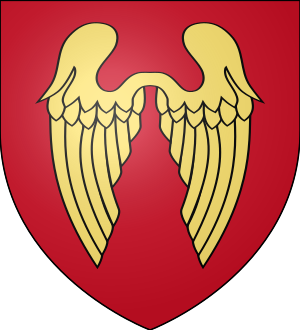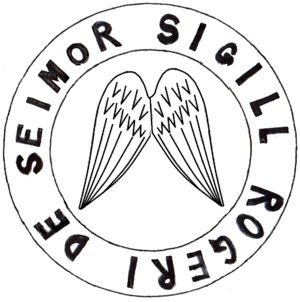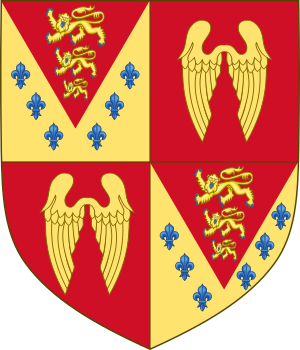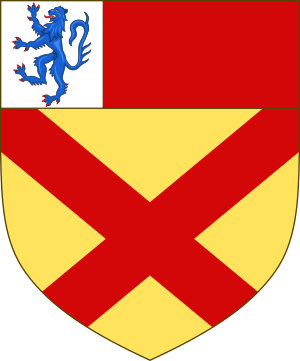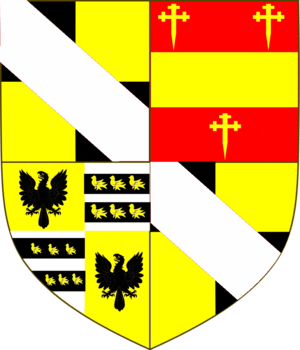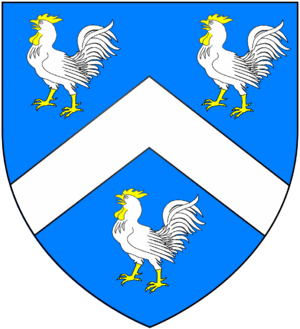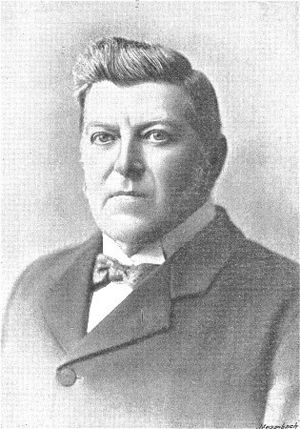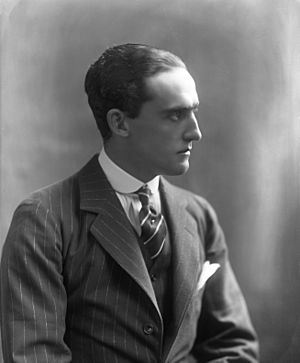Feudal barony of Hatch Beauchamp facts for kids
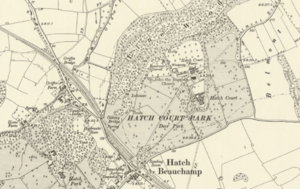
The feudal barony of Hatch Beauchamp was an important land area in England. Its main center was the manor of Hatch Beauchamp in Somerset. Today, the old manor house site is home to Hatch Court. This is a beautiful Grade I listed mansion built around 1755 in the Palladian style. This style is known for its grand, balanced, and classical look.
Contents
- What Does "Hatch" Mean?
- Who Owned Hatch Beauchamp?
- Saxon Times
- Norman Times
- The de Beauchamp Family
- The de Vautort ("de Beauchamp") Family
- The Seymour Family
- Sir Roger I Seymour (1314 – c. 1361)
- Sir William Seymour (c. 1342 – 1391)
- Roger II Seymour (c. 1367/70 – 1420)
- Sir John Seymour (c. 1395/1402 – 1464)
- John Seymour (died 1491)
- Sir John Seymour (1474–1536)
- Edward Seymour, 1st Duke of Somerset (c. 1500 – 1552)
- Edward Seymour, 1st Earl of Hertford (1539–1621)
- William Seymour, 2nd Duke of Somerset (1588–1660)
- William Seymour, 3rd Duke of Somerset (1654–1671)
- The Bruce Family
- The Uttermare Family
- The Collins Family
- The Gore-Langton Family
- The Oakes Family
- The Hardstaff Family
- The Lloyd Family
- The Gault Family
- The Odgers Family
- Sources
What Does "Hatch" Mean?
The old Saxon word Hache means "gateway." People believe that Hatch in Somerset was once the entrance to the royal hunting forest of Neroche. A small river called the River Rag flows through Hache. This river used to mark the northern edge of the forest.
Who Owned Hatch Beauchamp?
Over many centuries, different families owned the lands of Hatch Beauchamp. This section tells you about them.
Saxon Times
Before the Normans arrived, Hache was owned by Saxons. The Domesday Book of 1086, a famous survey of England, says that Godric, Godwin, and Bollo held the land from King Edward the Confessor, who died in 1066.
Norman Times
After the Norman Conquest, the land changed hands.
Robert, Count of Mortain
The Domesday Book of 1086 shows that Hache was given to Robert, Count of Mortain (around 1031–1090). He was the half-brother of King William the Conqueror. Robert Fitz Ivo, also known as "Robert the Constable," managed the land for the Count. When the Count of Mortain rebelled against King William's son, his lands were taken by the King. Soon after, they were given to the de Beauchamp family from Normandy.
The de Beauchamp Family
The early history of the de Beauchamp family at Hatch is a bit unclear.
- Robert I de Beauchamp (active 1092) was mentioned in a document in 1092.
- Robert II de Beauchamp (active 1158) was recorded in Somerset around 1150 and again in 1158. He might have been the "Robert de Beauchamp" who was a sheriff between 1176 and 1181. In 1166, a Robert de Beauchamp confirmed he held 17 knights' fees (areas of land given for military service) from the King.
- Robert III de Beauchamp (died 1195) had no sons. His only daughter married Simon de Vautort.
The de Vautort ("de Beauchamp") Family
Robert de Vautort/IV "de Beauchamp" (c. 1191 – 1251)
Robert de Vautort (around 1191–1251) was the son of Simon de Vautort and the de Beauchamp heiress. He was only about 8 when his father died. King John put him under the care of Hubert de Burgh. When Robert grew up, he took the name "de Beauchamp" instead of his father's name. He then took control of the Beauchamp lands.
Robert V de Beauchamp (died 1264)
Robert V de Beauchamp (died 1264) was Robert IV's son. King Henry III often called on him to serve in wars in Scotland and Wales. He married Alice de Mohun, whose family owned Dunster Castle in Somerset.
John I de Beauchamp (died 1283)
John I de Beauchamp (died 1283) was Robert V's son. He married Cecily de Vivonne, who inherited a share of the feudal barony of Curry Mallet in Somerset. John was a governor of Carmarthen Castle and Cardigan Castle in Wales. He also built a manor house at his other home, Stoke-sub-Hamdon. He died at Hatch and was buried in the church at Stoke-sub-Hamdon.
John II de Beauchamp, 1st Baron Beauchamp (1274–1336)
John II de Beauchamp, 1st Baron Beauchamp (1274–1336) was John I's son. In 1333, King Edward III gave him permission to add defenses to his home at Hatch. He also fought in wars in Scotland. In 1299, he was made a baron by the King, becoming "Baron Beauchamp de Somerset."
John III de Beauchamp, 2nd Baron Beauchamp (1306–1343)
John III de Beauchamp, 2nd Baron Beauchamp (1306–1343) was John II's son. He fought in wars in France. In 1301, he got permission to hold weekly markets and a fair at Hatch Beauchamp.
John IV de Beauchamp, 3rd Baron Beauchamp (1330–1361)
John IV de Beauchamp, 3rd Baron Beauchamp (1330–1361) was John III's son. He married Lady Alice Beauchamp, but they had no children. Because of this, the title of baron could not be passed on directly. His three aunts became the co-heiresses to the Hatch lands. Cecily de Beauchamp, who was married to Roger Seymour, received the main manor of Hatch.
The Seymour Family
The Seymour family (originally called de St Maur) first lived at Penhow Castle in Wales in the 12th century.
Sir Roger I Seymour (1314 – c. 1361)
Sir Roger I Seymour (1314-before 1361) married Cecily de Beauchamp, who inherited Hatch Beauchamp. Cecily received several manors, including Hatch Beauchamp, Shepton Beauchamp, and Shepton Mallet. She later married Sir Gilbert Turberville.
Sir William Seymour (c. 1342 – 1391)
Sir William Seymour (around 1342–1391) served under the Black Prince in France in 1362. He mainly lived at his manor of Undy in Monmouthshire.
Roger II Seymour (c. 1367/70 – 1420)
Roger II Seymour (around 1367/70–1420) married Maud Esturmy. Her family owned Wolfhall in Wiltshire. After his marriage, Roger moved his main home from Undy to Wolfhall.
Sir John Seymour (c. 1395/1402 – 1464)
Sir John Seymour (around 1395/1402–1464) was Roger II's son. He lived at Wolfhall and Hatch Beauchamp. He served as a Member of Parliament for Wiltshire several times. He also held the role of High Sheriff of Wiltshire. He married Isabel William, whose father was a merchant and Mayor of Bristol.
John Seymour (died 1491)
John Seymour (died 1491) was Sir John's grandson. His father, also named John Seymour, died before him. He married Elizabeth Darrell.
Sir John Seymour (1474–1536)
Sir John Seymour (1474–1536) was John's eldest son. He was knighted in 1497. He was the father of Queen Jane Seymour (1508–1537), who became the third wife of King Henry VIII.
Edward Seymour, 1st Duke of Somerset (c. 1500 – 1552)
Edward Seymour, 1st Duke of Somerset (around 1500–1552) was Sir John's eldest son. He was the uncle of King Edward VI and served as Lord Protector of England. When his sister married King Henry VIII, Edward was given the title Viscount Beauchamp of Hache. Later, he became the Earl of Hertford and then the Duke of Somerset. He likely lived at Hatch Court during this time. In 1552, the Duke was executed, and all his titles were taken away.
Edward Seymour, 1st Earl of Hertford (1539–1621)
Edward Seymour (1539–1621) did not inherit his father's titles because they were forfeited. However, in 1559, Queen Elizabeth I made him Baron Beauchamp and Earl of Hertford. He married three times. His eldest son, Edward Seymour (1561–1612), was known as Viscount Beauchamp. This son had a strong claim to the English throne through his mother, Lady Catherine Grey. However, when Queen Elizabeth I died, the throne went to King James VI of Scotland.
William Seymour, 2nd Duke of Somerset (1588–1660)
William Seymour, 2nd Duke of Somerset (1588–1660) inherited his grandfather's titles. In 1641, King Charles I made him Marquess of Hertford. When the monarchy was restored in 1660, he regained the Dukedom of Somerset. Around 1633, the historian Thomas Gerard visited the manor house. He noted that it was very ruined but still saw the family's coats of arms.
William Seymour, 3rd Duke of Somerset (1654–1671)
William Seymour, 3rd Duke of Somerset (1654–1671) was the grandson of the 2nd Duke. He died young, without marrying or having children. His sister, Lady Elizabeth Seymour, inherited his estates, but not the Dukedom.
The Bruce Family
Lady Elizabeth Seymour (around 1655–1697) inherited Hatch and other Seymour estates. In 1676, she married Thomas Bruce, 3rd Earl of Elgin. This meant the lands of Hatch passed to the Bruce family, but they did not keep them for long.
The Uttermare Family
- John Uttermare (died 1750) bought the ownership of Hatch Beauchamp manor in 1722. He and his family lived in a house called "Lodge."
- James Uttermare (died 1800)
- John Uttermare (died 1841). There is a monument to the Uttermare family in Hatch Beauchamp Church. His heir, Mr. R. J. Liston Foulis, sold the ownership of Hatch Beauchamp in 1905 to Mr. F. J. Rails.
The Collins Family
The Collins family owned the Hatch Beauchamp estate, but not the actual lordship of the manor.
- John Collins (1725–1792) came from a family of wool merchants. In 1755, he built the current Hatch Court. He was a sheriff in 1757. He married Jane Langford, who brought a lot of wealth from the West Indian sugar trade. He died in 1792, leaving five young children.
- John Raw Collins (died 1807) was his eldest son.
- Henry Powell Collins (1776–1854) was John Raw's younger brother. He was a Member of Parliament for Taunton twice. He lived at Hatch Court from 1809 to 1821. He built a private pew in Hatch Beauchamp Church. He died in 1854. His only child, Dorothea Jacintha Collins, died before him.
The Gore-Langton Family
- William Henry Powell Gore Langton (1824–1873) became the owner of Hatch Court in 1854 after his grandfather Henry Powell Collins died. He was also a Member of Parliament for West Somerset. He helped restore the church in 1867. He married Lady Anna Eliza Mary Temple-Grenville. Memorial windows for them are in Hatch Beauchamp Church. His younger son, Henry Powell Gore Langton, inherited Hatch Court.
- Henry Powell Gore Langton was the younger son and heir to Hatch Court.
- Commander Hubert Edwin Gore Langton (died 1968) was Henry Powell's son. He served in both World Wars and was a hero in World War I. In 1964, he gave land to the village for a memorial field. During World War II, evacuee children from London stayed at Hatch Park. In 1940, the house caught fire, and the family nurse, Miss Sarah Tennant, died trying to save the children. The old house was destroyed, and a new, smaller house was built on its site.
The Oakes Family
In the early 1800s, Hatch Court had many different residents. From 1838 to 1855, William Oakes owned it. There is a memorial to him in the church.
The Hardstaff Family
From 1856 until the end of the century, members of the Hardstaff family lived at Hatch Court. They were Methodists, and Henry Hardstaff built a small Methodist chapel near the park.
The Lloyd Family
In 1899, (William) Henry Lloyd (1839–1916) bought Hatch Court and its large estate. He was from the wealthy Lloyd family of Birmingham, who were Quakers. They were famous steel manufacturers and founded Lloyds Bank. Henry Lloyd was the fifth son of Samuel II "Quaker" Lloyd, who owned iron foundries. Henry Lloyd toured the United States and Canada to learn about new industries. He was also the Mayor of Wednesbury. He moved to Hatch Court in 1899 and lived there until he died in 1917. He improved the house and its grounds. He turned the Methodist chapel into a reading room for village boys. Because he was a Quaker, his wife managed the church duties for him. After his death, his widow remarried and moved to a smaller cottage on the estate.
The Gault Family
From 1923, Brigadier Andrew Hamilton Gault (1882–1958) and his wife Dorothy rented Hatch Court. In 1931, Brigadier Gault bought the property and gave it to his wife. He was the son of Andrew Frederick Gault, a wealthy merchant and industrialist from Canada. Brigadier Gault was a Member of Parliament for Taunton. He gave playing fields to the Borough of Taunton and was made a "Freeman of the Borough." He returned to Canada after World War II and died there in 1958. He founded Princess Patricia's Canadian Light Infantry, a famous regiment. A memorial to him is in Hatch Beauchamp Church. After his death, his widow returned to Hatch Court and invited her niece, Mrs Anne Blanche Townson, and her family to live with her.
The Odgers Family
Mrs Anne Townson's first husband died in 1967. In 1971, she remarried Barry Nation. In 1984, she passed Hatch Court to her daughter, Mrs Jane Margaret Odgers (born 1951). Jane had lived at Hatch Court as a child with her family to keep her great-aunt Dorothy Gault company. Jane remembers having breakfast with her great-aunt every Saturday. Jane's husband, Dr Robin Odgers, became the local doctor. He restored the large walled kitchen garden, selling produce to a local hotel. In 2000, they sold Hatch Court and moved to a smaller house. Jane's brother, John Townson (born 1949), still lives at Belmont Farm, which was once part of the Hatch estate.
Sources
- Sanders, I.J. English Baronies: A Study of their Origin and Descent 1086–1327, Oxford, 1960, p. 51, Hatch Beauchamp, Somerset
- Batten, John, The Barony of Beauchamp of Somerset, published in Proceedings of the Somerset Archaeological and Natural History Society, Vol.36.
- Cookson, Christopher, Hatch Beauchamp Church, section: Historical Note on the Church and its Associations, 1972
- Townson, John, John Bell Chirnside (1833–1902): His Life, Family and Descendants, 2009 . The author lives at Belmont Farm, Hatch Beauchamp, and is the son of Anne Blanche Townson (née Sykes) (1922–1995), owner Hatch Court.
- Collinson, John, History and Antiquities of the County of Somerset, Volume 1, Bath, 1791, pp. 43–6, Hatch-Beauchamp
- Wilhelmina, Duchess of Cleveland The Battle Abbey Roll with some Account of the Norman Lineages, 3 volumes, London, 1889, vol.1, Sent More


